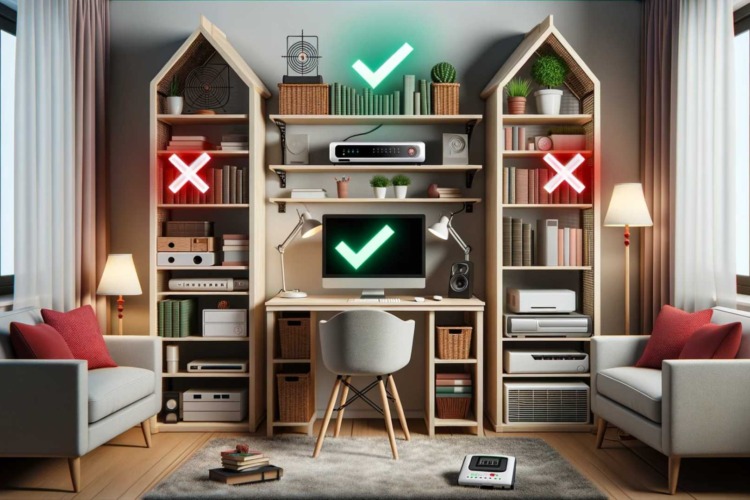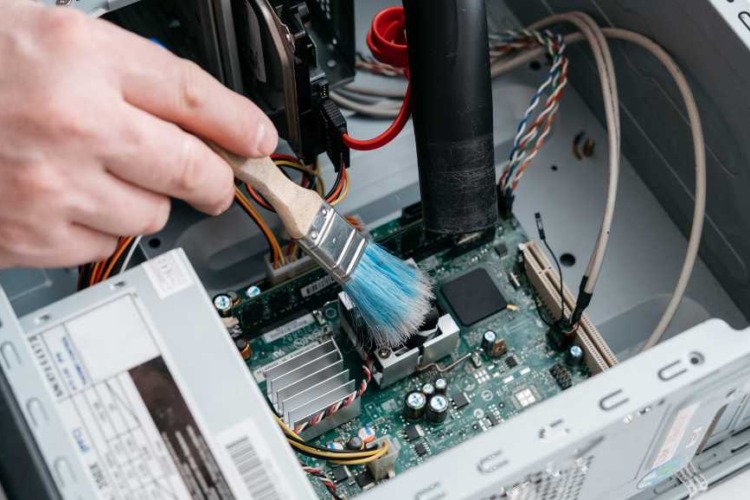

Why Desktop Cannot Connect To WiFi And How To Fix It
Have you ever faced the frustrating issue where your desktop cannot connect to WiFi? If so, you’re not alone. In today’s digital age, a stable WiFi connection is more than a luxury; it’s a necessity. Whether you’re working from home, streaming your favorite shows, or diving into the latest online game, WiFi is the backbone of our digital lives. So, when your desktop fails to connect, it can feel like your whole world comes to a screeching halt.
But don’t worry. We’ve got you covered. In this comprehensive guide, we’ll delve deep into the issue. We’ll start by understanding the basics of WiFi and why it’s so crucial for desktops. Next, we’ll help you identify the root cause of your connectivity problems. Moreover, we’ll walk you through a series of troubleshooting steps designed to get you back online. And that’s not all. We’ll also share expert tips and long-term solutions to ensure you don’t face this issue again.
So, why should you read this guide among the sea of articles out there? First, we offer a step-by-step approach to diagnosing and solving your problem. Second, we include expert advice that goes beyond the usual “turn it off and on again” solution. Lastly, we even provide a handy troubleshooting flowchart for quick problem identification.
In short, this blog post aims to be your one-stop solution for all issues related to “desktop cannot connect to WiFi.” So, let’s dive in and get that connection up and running again!
Table of Content:
Understanding the Basics
What is WiFi and How Does it Work?
Let’s start simple. WiFi stands for Wireless Fidelity. It’s a technology that allows devices to connect to the internet without wires. Essentially, a WiFi network uses radio waves to send and receive data. Your desktop, smartphone, or tablet communicates with a router, which is the hub of the network. So, in a nutshell, WiFi replaces the need for a physical, wired connection.
Importance of WiFi Connectivity for Desktops
Now, you might wonder, why is WiFi so crucial for desktops? Well, the answer is straightforward. In today’s world, almost everything is online. From work tasks to social interactions, we rely heavily on the internet. Therefore, a stable WiFi connection is not just convenient; it’s essential. Moreover, it offers the flexibility to set up your desktop anywhere in your home or office. No more being tethered to one spot because of an Ethernet cable!
Common Reasons for WiFi Issues
Alright, let’s get to the meat of the matter. Why do WiFi issues occur in the first place? First, it could be a hardware issue. Your router or desktop’s WiFi adapter might be failing. Second, software problems can also disrupt your connection. Outdated drivers or incorrect settings are common culprits. Additionally, network issues like low signal strength or congestion can interfere with your desktop’s ability to connect.
But wait, there’s more. External factors can also play a role. Other electronic devices, walls, and even your neighbor’s WiFi can cause interference. In short, a multitude of factors can contribute to your desktop’s inability to connect to WiFi.
Identifying the Problem
Hardware Checks
First things first, let’s talk about hardware. Your router and desktop’s WiFi adapter are the key players here. Start by examining your router. Is it on? Are the lights blinking as they should? If not, you might be dealing with a hardware failure. Next, check your desktop’s WiFi adapter. Usually, you’ll find a WiFi symbol in your taskbar if it’s working correctly. No symbol? You might need a new adapter.
Software Checks
Moving on to software, drivers are the backbone of any hardware component. Outdated or corrupt drivers can wreak havoc on your connection. So, make sure you have the latest drivers installed for your WiFi adapter. Additionally, check your operating system’s network settings. Incorrect configurations can prevent a successful connection. In short, your software settings need to be in tip-top shape.
Network Checks
Now, let’s consider the network itself. Signal strength is a crucial factor. A weak signal can result in a poor or nonexistent connection. Use your desktop or a mobile app to check the WiFi signal strength. Moreover, network congestion can also be a problem. Too many devices connected to the same network can slow things down. Therefore, consider disconnecting some devices if you’re experiencing issues.
External Interference
Lastly, don’t underestimate the power of external interference. Other electronic devices like microwaves or cordless phones can interfere with your WiFi signal. Even physical obstructions like walls and floors can be a problem. Additionally, your neighbor’s WiFi network might be on the same channel as yours, causing interference. So, it’s worth checking these external factors as well.
Troubleshooting Steps
Restarting Your Router and Desktop
Let’s start with the basics. Have you tried turning it off and on again? It sounds cliché, but it often works. First, unplug your router from the power source. Wait for about 30 seconds and then plug it back in. Similarly, restart your desktop. This simple step can resolve minor glitches and might just solve your problem.
Checking and Updating Network Drivers
Next on the list is checking your network drivers. Outdated drivers can be the root cause of many issues. So, head over to the Device Manager on your desktop. Locate the Network Adapters section and find your WiFi adapter. Right-click and choose “Update driver.” Follow the prompts and restart your computer. Updated drivers can make a world of difference.
Reconfiguring Network Settings
Now, let’s dive into network settings. Incorrect configurations can mess up your connection. Open the Network and Sharing Center on your desktop. Click on “Change adapter settings” and right-click on your WiFi network. Choose “Properties” and double-check the settings. Make sure everything aligns with your router’s configurations. If you’re unsure, consult your router’s manual or seek professional help.
Checking for Larger Service Outages
Moreover, sometimes the issue is out of your hands. Larger service outages can disrupt your connection. Check your ISP’s website or social media channels for any outage notifications. If you find one, all you can do is wait. However, it’s good to know the issue isn’t on your end.
Contacting Your ISP
If you’ve tried everything and still can’t connect, it’s time to call in the experts. Contact your Internet Service Provider (ISP) for assistance. They can run diagnostic tests that you can’t perform yourself. Additionally, they can guide you through more advanced troubleshooting steps. Sometimes, the issue might be on their end, and a service visit may be required.
Expert Tips for Advanced Users
Lastly, for those who are tech-savvy, here are some expert tips. You can try changing your WiFi channel to avoid interference from other networks. Access your router’s settings through a web browser and look for the channel settings. Switch to a less crowded channel and see if that improves your connection. Another tip is to use a WiFi analyzer tool. These tools can provide insights into network performance and help you identify issues you might not be aware of.
Long-Term Solutions
Investing in a Quality Router
Firstly, let’s talk about the heart of your home network: the router. A high-quality router can make a significant difference in your WiFi experience. If you’re using an older model, consider upgrading. Newer routers offer better range, speed, and security features. Moreover, they’re more capable of handling multiple devices. So, if you’re serious about a stable connection, invest in a good router.
Regularly Updating Your Software
Next, let’s not forget about software updates. They’re not just annoying pop-ups; they’re essential. Software updates often include fixes for known bugs and security vulnerabilities. Therefore, make sure your operating system and network drivers are up-to-date. Set reminders or enable automatic updates to keep your system current. In short, staying updated can save you from a lot of headaches down the line.
Optimal Placement of Router

Now, where you place your router matters more than you might think. Walls, floors, and even furniture can interfere with your WiFi signal. For the best results, place your router in a central location. Additionally, keep it elevated and away from other electronic devices. This simple step can improve your WiFi coverage dramatically.
Using Network Management Tools
Furthermore, network management tools can be a lifesaver. These tools allow you to monitor and manage your network’s performance. You can identify which devices are hogging bandwidth and even set priority levels. Some advanced routers come with built-in network management features. However, third-party software can also do the trick. So, take advantage of these tools to optimize your network.
Setting Up a Guest Network
Another smart move is setting up a guest network. This is especially useful if you frequently have visitors who need WiFi access. A guest network isolates your main network, adding an extra layer of security. Moreover, it prevents your guests from slowing down your connection. It’s a win-win situation.
Steps to Set Up a Guest Network
Access Router Settings: Open a web browser and enter your router’s IP address, usually something like
192.168.1.1or192.168.0.1. Log in using your admin username and password.Navigate to Guest Network Settings: Once logged in, look for an option that says “Guest Network,” “Guest Access,” or something similar. This is often found under the “Wireless” or “Advanced” tab.
Enable Guest Network: There should be an option to enable or disable the guest network. Make sure to enable it.
Configure Network Name (SSID): You’ll have the option to name your guest network. Choose a name that’s different from your main network to avoid confusion.
Set Up a Password: It’s a good idea to password-protect your guest network to prevent unauthorized access. Some routers offer the option to leave the network open, but it’s safer to set a password.
Set Bandwidth Limits: Some routers allow you to limit the bandwidth on your guest network. This ensures that your guests can’t slow down your main network.
Isolate the Network: If available, enable options that prevent guests from accessing your local network resources like shared files or printers.
Save and Apply: Once you’ve configured all settings, save and apply them. Your router may need to reboot for the changes to take effect.
Test the Network: Use a device to connect to the guest network using the new SSID and password to make sure everything is working as expected.
Important Points to Consider
- Security: Always set a strong password for your guest network.
- Expiration: Some routers allow you to set an expiration time for the guest network, which is useful for temporary access.
- User Limit: You may also be able to limit the number of users who can connect to the guest network at one time.
Remember, these are general steps and the exact procedure may vary depending on your router’s make and model. Always refer to your router’s manual for specific instructions.
Using Quality of Service (QoS) Settings
Lastly, Quality of Service (QoS) settings can be a game-changer. These settings allow you to prioritize certain types of traffic over others. For example, you can give priority to video streaming or online gaming. This ensures a smoother experience when using bandwidth-intensive applications. To access QoS settings, log into your router’s web interface. From there, you can customize your preferences.
Steps to Use Quality of Service (QoS) Settings
Access Router Settings: Open a web browser and enter your router’s IP address, typically
192.168.1.1or192.168.0.1. Log in using your admin credentials.Navigate to QoS Settings: Once logged in, look for the QoS settings. This is often found under tabs like “Advanced,” “QoS,” or “Traffic Control.”
Enable QoS: Most routers have an option to enable or disable QoS. Make sure it’s enabled to proceed.
Select Traffic Type: You’ll usually find options to prioritize different types of traffic like gaming, streaming, web browsing, etc. Choose the type you want to prioritize.
Set Priority Levels: Some routers allow you to set priority levels like “High,” “Medium,” and “Low” for different types of traffic or even specific devices.
Bandwidth Allocation: You may also have the option to allocate a specific amount of bandwidth to different types of traffic or devices.
Apply MAC or IP Filters: Some advanced QoS settings allow you to prioritize traffic for specific devices based on their MAC or IP addresses.
Save and Apply: After configuring your settings, make sure to save and apply them. Your router may need to reboot for the changes to take effect.
Test: Finally, test your settings to ensure they’re working as expected. You can do this by running speed tests or simply observing performance during high-traffic activities like streaming or gaming.
Important Points to Consider
- Consistency: QoS settings are not a one-time fix. You may need to adjust them as your network needs change.
- Compatibility: Not all routers support QoS settings. Check your router’s manual to see if this feature is available.
- Expert Advice: If you’re unsure about what settings to use, consult your router’s manual or seek expert advice.
Remember, these are general guidelines, and the exact steps may vary depending on your router’s brand and model. Always refer to your router’s manual for specific instructions.
Frequently Asked Questions (FAQs) relating to Why Desktop Cannot Connect to WiFi
1. Why is my desktop not connecting to WiFi even after restarting?
Firstly, if a simple restart doesn’t solve the problem, the issue could be more complex. It might be related to outdated drivers, incorrect network settings, or even hardware failure. This guide covers various troubleshooting steps you can follow to identify and fix the issue.
2. How do I know if the problem is with my desktop or my router?
Great question. To isolate the issue, try connecting other devices to the same WiFi network. If they connect without a problem, your desktop is likely the culprit. However, if other devices also struggle to connect, your router might be the issue.
3. Can software updates really make a difference in WiFi connectivity?
Absolutely. Software updates often include fixes for bugs and security vulnerabilities that could be affecting your connection. Therefore, keeping your system and drivers updated is crucial for optimal performance.
4. When should I consider replacing my router?
If you’re using an older router and facing constant connectivity issues, it might be time for an upgrade. Newer models offer better speed, range, and security features. Moreover, technology evolves, and older routers may not support newer devices as effectively.
5. Is it safe to try troubleshooting steps on my own?
Yes, most basic troubleshooting steps are safe and won’t harm your system. However, if you’re not comfortable with more advanced procedures, it’s best to seek professional help. Especially if your desktop is under warranty, you’ll want to avoid any DIY fixes that could void it.
When to Seek Help from a Desktop Repair Shop
Sometimes, despite your best efforts, the issue persists. In such cases, it might be time to consider professional help. But how do you know when it’s time to take your desktop to a repair shop? Let’s explore some signs.
Persistent Hardware Issues
Firstly, if you’ve ruled out software and network issues, the problem might be hardware-related. For example, if your WiFi adapter is failing or your motherboard shows signs of wear, a repair shop can help. Moreover, hardware issues often require specialized tools and expertise to fix.
Repeated Software Failures
Next, if you’ve tried updating drivers and tweaking settings with no luck, it could be a deeper software issue. Corrupted system files or complex software conflicts can be tricky to resolve. Therefore, a professional diagnosis might be necessary.
Unidentified Network Issues
Additionally, if you’ve exhausted all troubleshooting steps and your desktop still can’t connect, it’s time for expert intervention. A repair shop can run advanced diagnostic tests that go beyond basic troubleshooting. They can identify issues that aren’t easily detectable at home.
When Time is of the Essence
Furthermore, if you rely heavily on your desktop for work or other important tasks, time is crucial. The quicker you resolve the issue, the better. In such cases, a repair shop can offer a fast and reliable solution.
Warranty Considerations
Lastly, if your desktop is still under warranty, a certified repair shop should be your go-to option. DIY fixes might void your warranty, so it’s safer to seek professional help.
Where to Fix Desktop Cannot Connect to WiFi in Singapore
If you’ve tried all the troubleshooting steps and long-term solutions but still can’t resolve your issue, it might be time to seek professional help. For those of you in Singapore, we highly recommend Volta PC Upgrade & Repair.
Why Choose Volta PC Upgrade & Repair?
Firstly, they offer a comprehensive range of desktop repair services, from hardware repairs to software troubleshooting. Moreover, their team of experts is highly skilled in diagnosing and fixing WiFi connectivity issues. So, you can trust them to get your desktop back online.
Additionally, their customer reviews speak volumes about their quality of service. Fast, reliable, and affordable—what more could you ask for?
How to Contact Them
You can reach out to Volta PC Upgrade & Repair through:
Address:
- Tai Seng Branch: 8 Burn Road #01-04, Trivex, Singapore 369977
- Jurong Branch: Blk 132 #01-279C, Jurong Gateway Road, Singapore 600132


